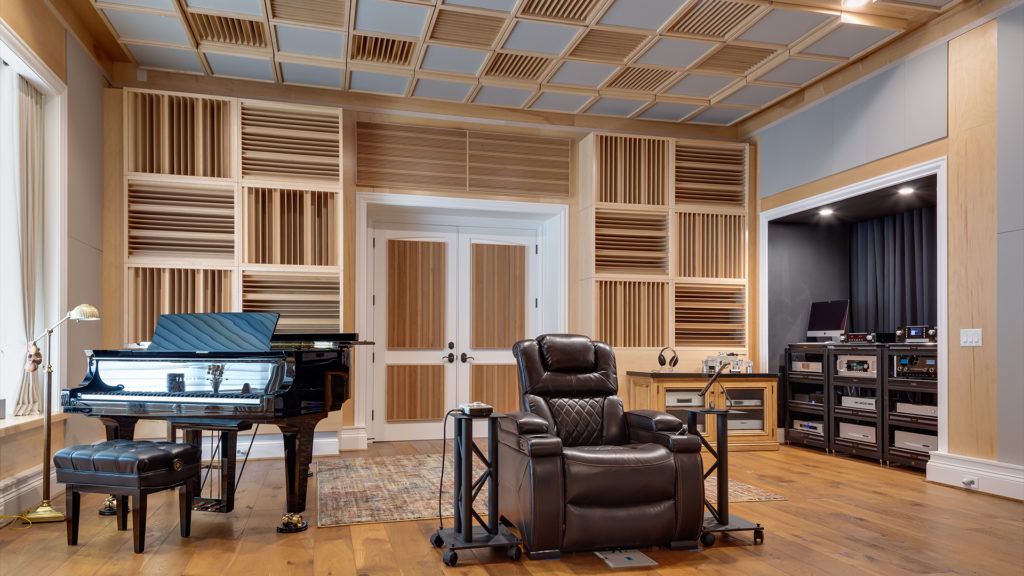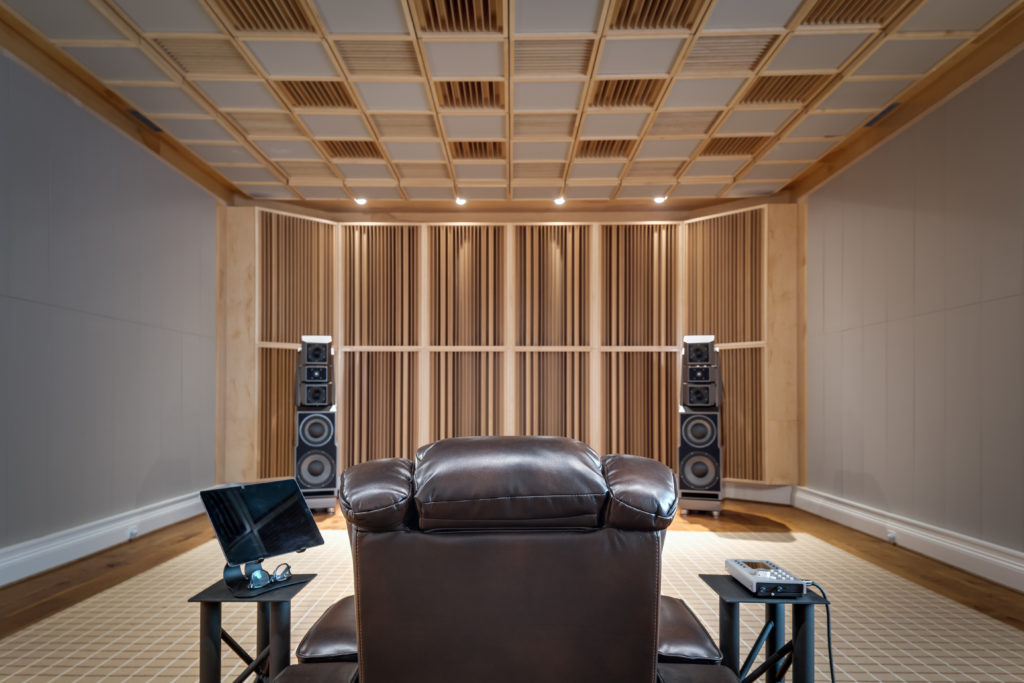We have learned many new things since this blog was posted. We have updated this post on Skyline® Acoustic Diffuser technology on 11 / 3 / 19
In last week’s Hangout, I was asked: “What’s your opinion about a Skyline® acoustic diffuser compared to your quadratic diffusers?” Skyline® is a product name created by Peter D’ Antonio of RPG. It’s a two-dimensional diffuser. It’s a series of blocks at different heights which is just the invert of a quadratic. If you take a one-dimensional quadratic diffuser that we market and flip it inside out you get a two-dimensional Skyline® acoustic diffuser. It’s called Skyline® because it looks like the skyline of a city.
There are two types of diffusers when it comes to quadratics. There are one dimensional and two-dimensional diffusers. They are given these names by the way they are placed within a room. There are vertical diffusers and horizontal diffusers. A vertically placed diffuser will diffuse energy in the horizontal domain. A horizontally placed diffuser will spread the energy out in the horizontal domain. A two-dimensional diffuser is a combination of vertical and horizontal diffusers.
Quadratic diffusion definition: https://en.wikipedia.org/wiki/Diffusion_(acoustics)
Quadratic diffuser creator: https://pages.mtu.edu/~suits/diffusers.html
A skyline acoustic diffuser is an example of a two-dimensional diffuser. It incorporates both vertical and horizontal diffusion in one product which is called a skyline diffuser. Technically it is a two-dimensional diffuser with the name skyline diffuser. Two-dimensional diffusers can be used when there is not enough distance for a one-dimensional diffuser.
Diffuser Speakers
Diffusers are like speakers. They have a frequency response. They are designed to cover a certain frequency response to match your needs and usage. The wells or troughs of the diffuser determine the wavelength of energy that will be diffused. The depth of each well is determined using quarter wavelength rule. The width of each well is determined by half wavelength. Since diffusers are distant dependent you must have enough distance for the lowest frequency produced by the diffuser to fully form after it leaves the diffuser.
The best material to make a diffuser out of is wood. Wood has the best tonal qualities for middle and high frequencies. We use softer woods for our diffusers since they produce the best tonal qualities. Diffusers work in the middle range frequencies starting from 200 – 300 Hz. and going up through 3,500 – 4,000 Hz. Woods to consider are pine, alder, birch. Any softer wood will produce the best tonal qualities for middle-range frequencies which include voice and music.
Where are you going to put it?
Diffusion technology placement is dependent on the usage of your room. If you have a two-channel listening room, you will put diffusion on the front and rear walls. Vertical diffusion for the front wall and either vertical or horizontal diffusion for the rear wall. For home theater, you will place diffusion on the ceiling and rear wall. If you have a control room, you should consider diffusion for the rear wall to minimize the reflections from the rear wall so they are not heard in your mixes.
Diffusion is a technology to make a small room sound larger. Reflections from our wall surfaces help us and hurt us. They help us because they aid us in determining distances. The reflection from the wall surfaces within our rooms helps our brain locate how far away the wall is. The reflections from our walls hurt us by raising reverberation times. Reverberation times are the summation of all the reflections from wall surfaces. Reverberberation times are room distortion and confuse our hearing and processing of our music and voice.
Diffusers
A diffuser is a tool that helps us deal with these reflections It does this by spreading the sound that enters into the diffuser out in 180-degree arrays of energy. If you position a quadratic diffuser in a vertical position it spreads the sound out in a horizontal array. If you position a quadratic diffuser in a horizontal position it will spread the sound out in a vertical array. What orientation you place the diffuser at depends on the distance you have from the diffuser to the receiver or your ears. It also depends on the usage of your room
Quadratic Diffusers
Quadratic diffusion is the only true diffuser that satisfies five rigid requirements in small rooms. We have three sound fields within our rooms. We have floor to ceiling, sidewall to sidewall, and front to rear walls. To achieve a truly balanced sound field in all of these three areas, you must manage five rigid criteria involving decay rates and spatial irregularities in frequency response along with decay rates throughout the room.
Many Pieces – Heavy
It’s very heavy because of the solid wood. You’ve got sixty to eighty pieces, nine inches tall, four inches tall, two inches tall, one inch tall. So you’ve got ninety pieces like building blocks like the blocks you had when you were a child. You’ve got ninety pieces on two-foot by two-foot piece of wood, a piece of wood that you put it on is going to weigh eight to ten pounds so that’s probably ninety to a hundred pounds apiece. That takes two guys to lift one! I would like to build some, I mean I wish we would get a project for that to happen but nobody’s going to spend that kind of money.










I am not sure if you can help me bu I have an downstairs sound problem and a friend told me about the skyline foam option. The idea is to sandwich the foam to the ceiling and some type of drop ceiling with air in between. The problem is we have 1400 sq.’ and I am looking for a sure fire/reasonable solution. What are your thoughts?
Hi Allyn, Skyline is the product name for a two dimensional diffuser manufactured by RPG. Foam is a middle and high frequency absorption technology. They are two different technologies with different applications. It appears you are looking for low frequency absorption technology from your text, but I do not know for sure and I am not a big fan of guessing. Fill out the information in this link and I can better assist you. https://www.acousticfields.com/free-room-analysis/
Dear my problem is different I have a room10feet x 12feet and want to have Macaw Parrots in it but I am worried about my neighbours…. Is skyline is suitable for me or what other solution… So worried.
The room walls, roof and flooring made with solid bricks and concrete but problem is from windows as its necessary coz of fresh air..
J, Its appears to be a noise issue. Diffusion of any type will not assist you with noise. You must use absorption inside the room.